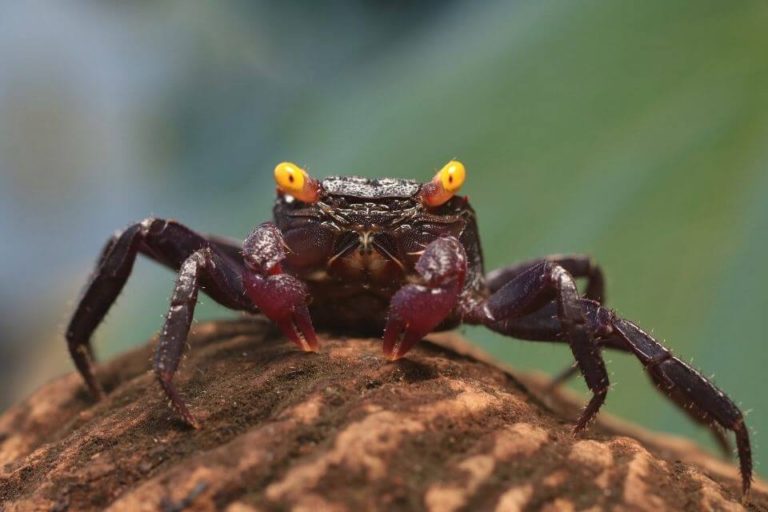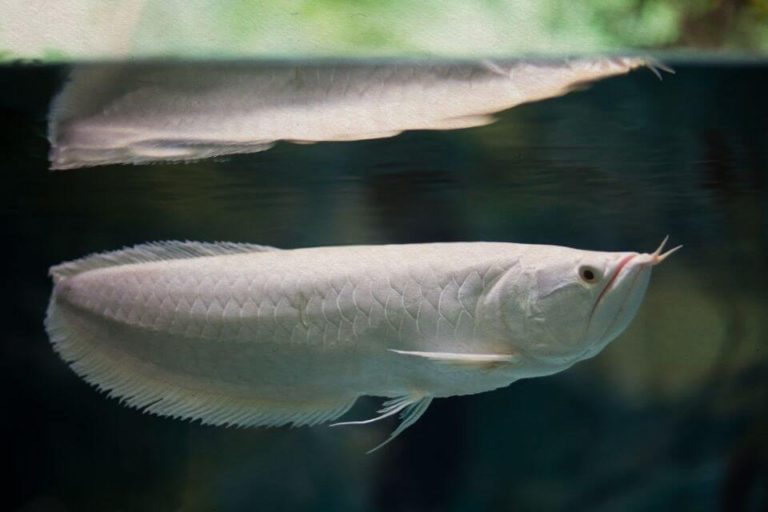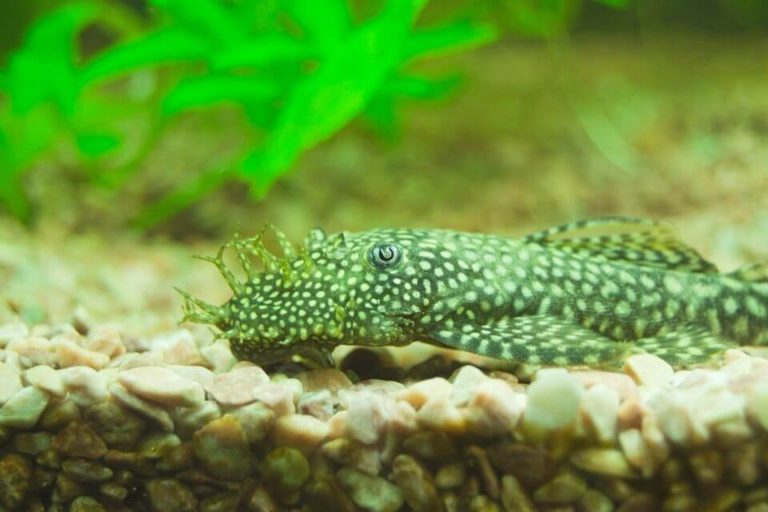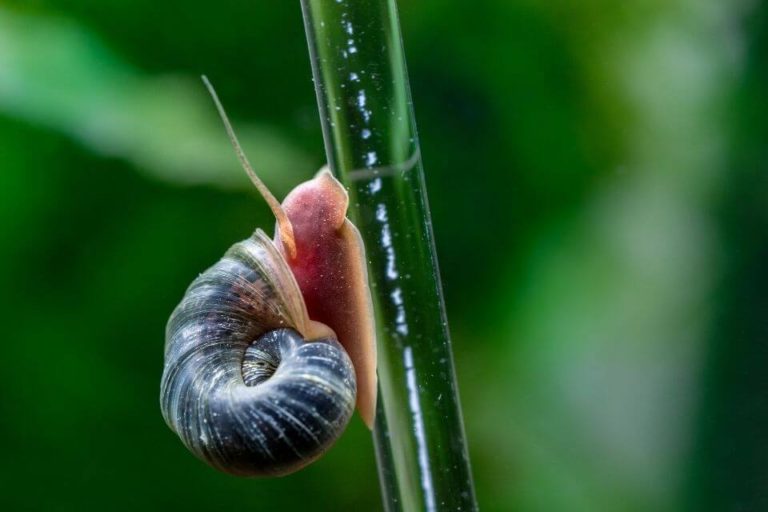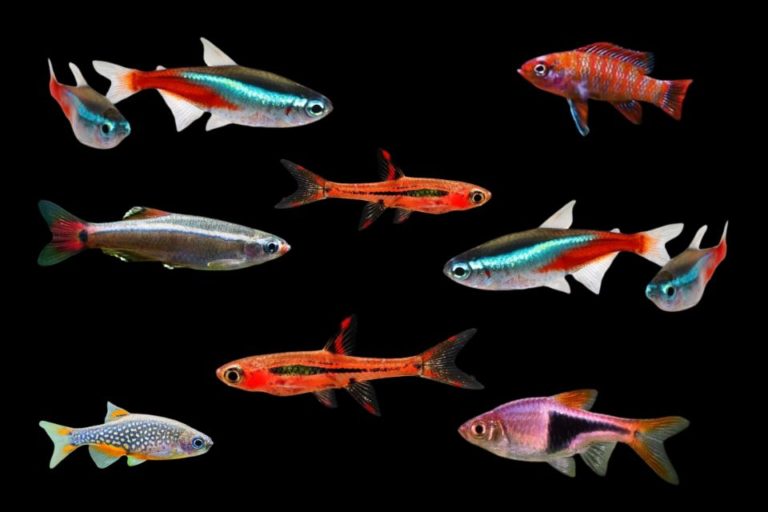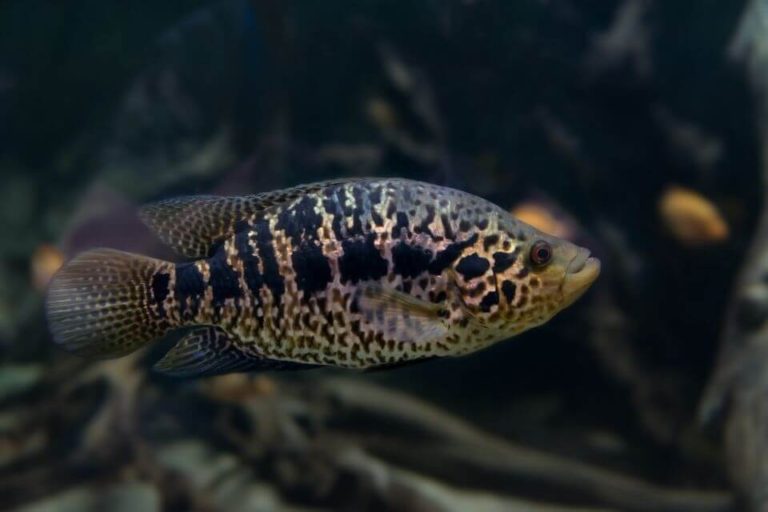Top 10 Small Pleco Species Perfect for Nano Tanks
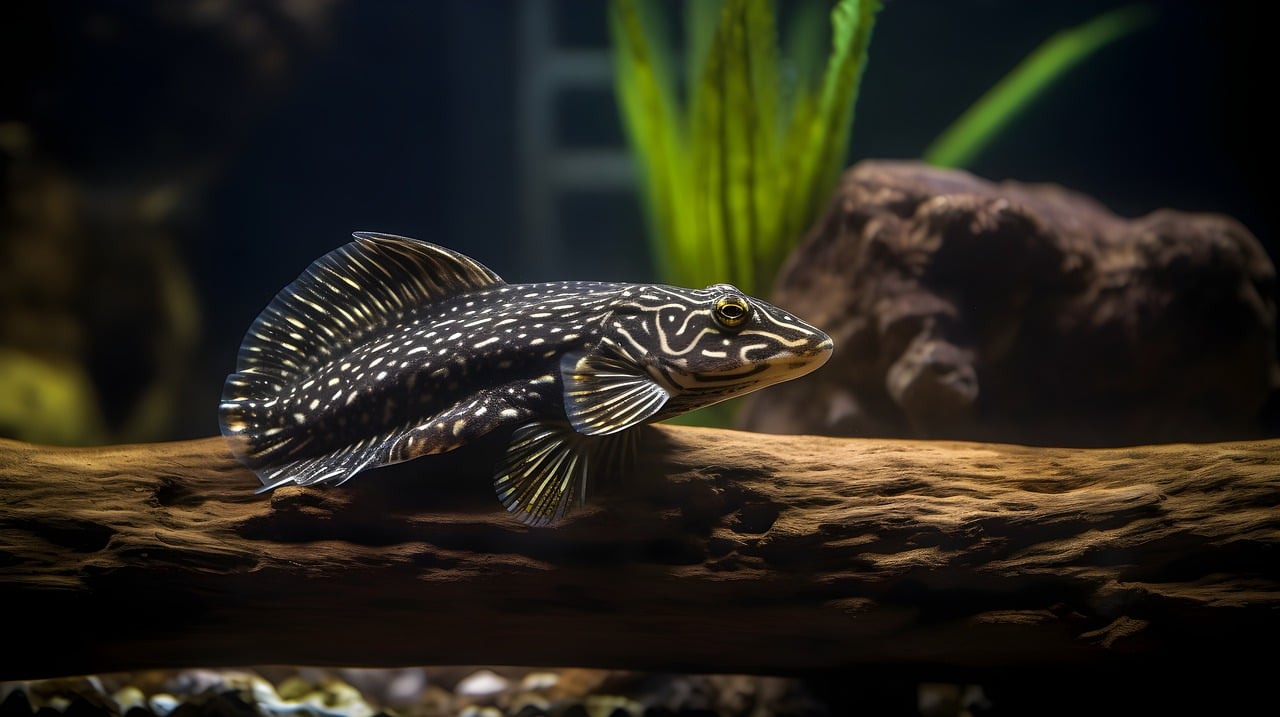
If you’re into nano tanks, small pleco species are a perfect addition. These tiny, fascinating fish not only bring charm but also help keep tanks clean. Unlike their larger relatives, small plecos fit comfortably in compact spaces, making them a favorite for hobbyists with limited room. In this post, I’ll highlight the top 10 small pleco species ideal for nano tanks and why they’re such great choices for these setups.
What Makes Small Pleco Species Ideal for Nano Tanks?
Small pleco species are a fantastic choice for nano tanks. Their compact size, adaptability, and calm behavior make them a perfect fit for these setups. Let’s break down why these little fish shine in small tanks.
Space Requirements: How Size Matters in Nano Tanks
The most obvious advantage of small pleco species is their size. Many of these fish grow no larger than 3 to 4 inches, which is ideal for tanks under 20 gallons. Nano tanks thrive on balance, and keeping appropriately sized fish helps maintain that. A large fish in a small tank can feel cramped and stressed. Smaller plecos, on the other hand, move comfortably and have enough room to explore.
Another benefit of their size? More space for aquascaping! With small plecos, you can use stones, driftwood, and plants to create a natural, visually appealing environment without overcrowding. They fit into tight hiding spots and thrive in spaces that mimic their natural habitats. It’s all about maximizing the tank’s potential.
Water Conditions: Adaptable and Easy to Maintain
Most small pleco species are hardy and can adapt to a range of water conditions, which is great for nano tanks. They generally thrive in water temperatures between 72°F and 82°F and prefer a pH range of 6.5 to 7.5. That flexibility makes it easier for beginner and experienced hobbyists alike to meet their needs.
Many nano tank setups already aim for water parameters that align with the needs of small plecos. Plus, these fish are great at tolerating slight fluctuations, as long as you maintain stable conditions over the long run. Still, it’s always good practice to research the specific species you’re housing since some may have slightly different requirements. For example, the Oto Catfish, a popular small pleco, needs pristine water to thrive.
Also, keep in mind that plecos can be sensitive to high nitrate levels. With the smaller volume of nano tanks, you’ll need to keep up with regular water changes to maintain quality. That said, their hardiness makes them a relatively low-maintenance fish for such a small tank.
Behavior in Smaller Spaces: Peaceful and Fun to Watch
Small pleco species tend to be social yet low-key, which is perfect for nano tanks. Despite their shy nature, they aren’t reclusive. You’ll often see them cruising along the glass, nibbling algae off rocks, or darting into their favorite hiding spots.
One of the coolest things about small plecos is how they interact with their environment. They’re natural cleaners, eating algae and leftover food, helping to keep the tank tidy. Think of them as tiny custodians for your nano setup. Even in smaller tanks, they tend to stick to themselves, rarely bothering other tankmates. This peaceful attitude makes them compatible with other nano fish, like tetras or rasboras.
Still, it’s important to provide plenty of hiding spaces, like caves or planted areas. Even though they’re comfortable in smaller environments, these fish need spots to retreat and feel secure. The right setup can encourage their natural behavior without causing stress.
By choosing small pleco species, you’re getting a fish that not only thrives in compact spaces but also contributes to the beauty and balance of your nano tank. It’s a win-win for both the fish and the hobbyist!
Top 10 Small Pleco Species for Nano Tanks
Small pleco species are an exciting choice for nano tank setups. They bring a unique mix of utility, personality, and beauty to smaller aquariums. If you’re looking for fish that stay small, clean algae, and are easy to care for, these species make great options. Let me share some of the best choices for nano tanks.
1. Bristlenose Pleco
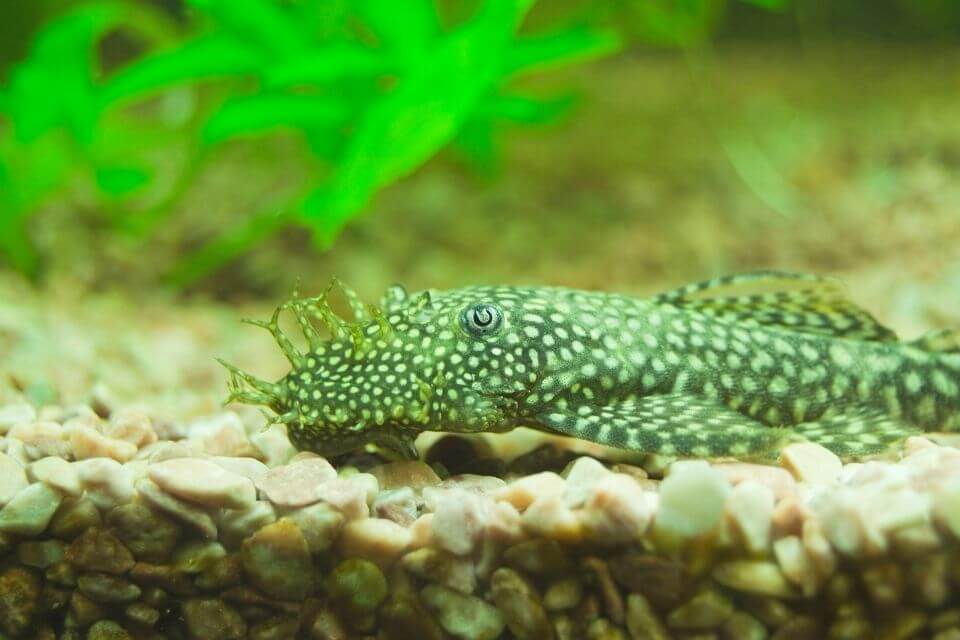
The Bristlenose Pleco is a small, peaceful freshwater fish native to South America’s rivers, streams, and floodplains. It stays relatively small, usually growing to about 4 to 5 inches, which makes it perfect for most tanks.
They live around 5 to 10 years if cared for properly. These fish are algae-eaters and thrive on a diet of algae wafers, fresh vegetables like zucchini or spinach, and occasional protein-based food like shrimp pellets.
They’re nocturnal, active at night, and spend much of their time cleaning surfaces with their sucker-shaped mouths. They need a tank of at least 30 gallons with plenty of hiding spots, like driftwood and caves.
For water, they prefer temperatures between 65 to 80°F, a pH of 6.5 to 7.5, and soft to moderate hardness. Their calm nature makes them great tank mates, but they need space to avoid stress.
They’re hardy and adaptable, but clean water and stable conditions are essential for their health.
2. Clown Pleco
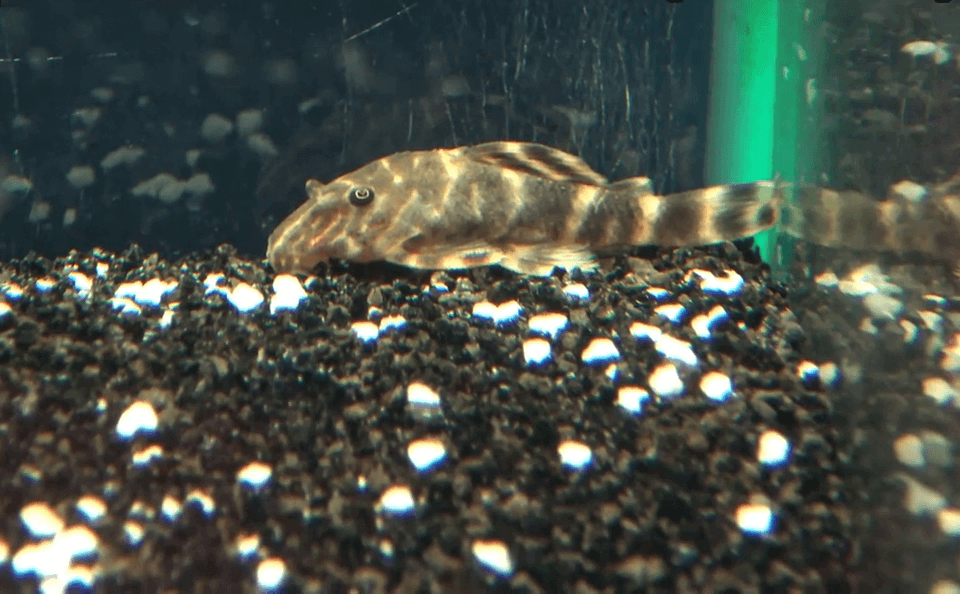
The Clown Pleco (Panaqolus maccus) is a small, peaceful freshwater fish native to Venezuela’s Orinoco River basin. It lives in slow-moving waters filled with driftwood and plants, where it uses wood both for hiding and eating.
Adults usually grow up to 3.5 to 4 inches and have a lifespan of 10 to 12 years with good care. They are nocturnal and spend much of their time hidden during the day, becoming more active at night to forage.
Clown Plecos are herbivores, primarily feeding on driftwood, algae, and plant matter. You can supplement their diet with sinking algae wafers, blanched vegetables like zucchini, and occasional protein sources like bloodworms.
They thrive in tanks of at least 20 gallons (only one fish) with a sandy or smooth gravel substrate and plenty of driftwood, which they also eat. Water should stay between 73 to 83°F, with a pH of 6.5 to 7.5 and soft to mildly hard conditions.
As bottom dwellers, they do best in tanks with subdued lighting and minimal disturbances. Keep the tank clean but avoid stripping it of biofilm since they rely on it for food. Clown Plecos can live peacefully with small, non-aggressive fish, but avoid housing them with territorial species.
3. Rubber Lip Pleco
The Rubber Lip Pleco is a lesser-known species but shines for its hardworking nature and gentle demeanor.
- Behavior and characteristics: These fish have a strong algae-eating instinct. They’re calm and will happily explore the bottom of the tank.
- Size and lifespan: At maturity, they reach 4-5 inches and live up to 12 years.
- Tankmates: Peaceful fish like danios, corydoras, and mollies are great companions. Avoid aggressive or territorial species.
- Tank requirements: Provide a 20-gallon or larger tank with smooth rocks for algae grazing. Maintain water at 72°F to 80°F with a pH of 6.5 to 7.5.
4. Pitbull Pleco
The Pitbull Pleco is small, cute, and highly social. It’s an excellent choice for nano tanks due to its compact size.
- Behavior and characteristics: These playful plecos are active during the day and prefer staying in small groups. They eat algae and other detritus.
- Size and lifespan: They barely reach 2.5 inches and live for around 10 years.
- Tankmates: Peaceful fish like neon tetras, endlers, or dwarf shrimp make excellent tankmates.
- Tank requirements: A 10-15 gallon tank is sufficient. Add soft substrates, hiding spaces, and keep water at 72°F to 78°F with a pH of 6.2 to 7.2.
5. Gold Nugget Pleco
The Gold Nugget Pleco is a visually stunning species with bright yellow spots on a dark body.
- Behavior and characteristics: They’re a bit shy and prefer to stay hidden during the day. They love grazing on algae and prefer protein-based food occasionally.
- Size and lifespan: They grow to 6-7 inches, slightly larger than others but manageable, and live up to 15+ years.
- Tankmates: Best with other peaceful species. Avoid aggressive or overly active fish.
- Tank requirements: A 30-gallon tank is ideal with plenty of caves and driftwood. Maintain water between 75°F and 86°F and pH between 6.5 and 7.5.
6. Zebra Pleco
The striking Zebra Pleco, with its bold black-and-white stripes, is a true showstopper in nano tanks.
- Behavior and characteristics: These peaceful, nocturnal plecos favor slow currents and love hiding spots. They tend to enjoy more meaty foods instead of algae.
- Size and lifespan: They max out at 3-4 inches and can live for 10+ years.
- Tankmates: Suitable tankmates include peaceful species like small rasboras or ember tetras.
- Tank requirements: A minimum of 20 gallons is recommended with plenty of oxygenation and hiding places. Keep water temperature between 77°F and 86°F, and pH around 6.5 to 7.0.
7. Snowball Pleco
The Snowball Pleco is named for its distinct white polka dots against a velvety black body.
- Behavior and characteristics: Usually shy, they’re peaceful bottom-dwellers. They thrive on a mix of algae and sinking pellets.
- Size and lifespan: Typically, they grow up to 5-6 inches and can live up to 12 years.
- Tankmates: Pair with calm fish like corydoras, kuhli loaches, or cardinal tetras.
- Tank requirements: A 30-gallon tank is best, with plenty of hiding spaces. Keep temperatures between 73°F and 82°F with a pH of 6.5 to 7.5.
8. Blue Phantom Pleco
The Blue Phantom Pleco is known for its deep blue body speckled with lighter spots, offering a dramatic look in any tank.
- Behavior and characteristics: They’re calm and spend most of their time scavenging. They love meaty foods alongside veggies.
- Size and lifespan: They reach 6 inches in length and live around 10-12 years.
- Tankmates: Ideal with peaceful species like dwarf cichlids, small tetras, or gouramis.
- Tank requirements: A 20-gallon tank with driftwood and caves works well. Keep water at 72°F to 82°F and pH between 6.0 and 7.5.
9. Leopard Frog Pleco
The Leopard Frog Pleco stands out with its greenish-yellow body and dark leopard-like spots.
- Behavior and characteristics: They’re active at night and love exploring tanks. They enjoy a mix of algae-based and protein-rich diets.
- Size and lifespan: At full size, they reach 3.5-4 inches and have a lifespan of up to 10 years.
- Tankmates: Best kept with peaceful fish like pencilfish or hatchetfish. Avoid boisterous species.
- Tank requirements: A 20-gallon tank with strong filtration and driftwood suits them well. Water temperature should stay between 77°F
How to Care for Small Pleco Species
Caring for small pleco species doesn’t have to be complicated if you know what they need. These hardworking fish are low-maintenance, but providing the right diet, environment, and water conditions will keep them happy and healthy.
Feeding: Describe what to feed and feeding frequency
Small pleco species are mainly bottom-dwellers with a love for algae, but their diet can’t rely on algae alone. A balanced feeding routine is essential. I like to use a mix of high-quality sinking pellets, wafers, and fresh vegetables.
- Staple foods: Sinking pellets or algae wafers should be the core of their diet.
- Fresh veggies: Zucchini, cucumber, spinach, or blanched peas are great choices. A small slice every couple of days works.
- Protein treats: Occasionally, I add frozen bloodworms or shrimp pellets to give them extra nutrients. This keeps them healthy and energetic.
Feeding once a day is usually enough for small plecos. Make sure food reaches the bottom where they forage. Remove uneaten portions after a few hours to avoid water quality issues.
Tank Setup: Mention plant choices, hiding spots, and tank mates
Small pleco species thrive when their tank setup mimics their natural habitat. Think of a layout that balances open spaces with plenty of hiding spots and soft lighting.
- Hiding spots: Caves, driftwood, and rock crevices give them safe spaces to retreat. Plecos love to hide during the day, so ensure there are multiple options.
- Plants: Add hardy plants like Anubias, Java Fern, or Cryptocoryne. These provide natural shade, and plecos won’t eat them. Floating plants can help diffuse light, making the tank feel cozy.
- Substrate: Use soft sand or smooth gravel since plecos spend a lot of time at the bottom. Sharp substrates could injure their delicate undersides.
When it comes to tank mates, go for peaceful species. Neon tetras, corydoras, rasboras, or dwarf shrimp are ideal. Avoid aggressive fish or fin-nippers, as they can stress plecos. Small pleco species are generally peaceful and socialize well with community fish, but they do need their personal space to feel secure.
Water Maintenance: Discuss water changes and filtration
Maintaining clean water is critical for small pleco species, especially in nano tanks. These tanks are more prone to fluctuations, so consistency is key.
- Water changes: I recommend a 25-30% water change every week to keep nitrate levels low. Since plecos are sensitive to poor water quality, staying on top of this routine is non-negotiable.
- Filtration: A good filter is essential. Choose one with gentle flow, as most small pleco species prefer calm waters. Sponge filters or canister filters work well. They keep the water clean without creating strong currents.
- Water parameters: Aim for a temperature of 72°F to 82°F and a pH between 6.5 and 7.5. Testing the water regularly ensures stability. A stable environment is more important than perfection.
One tip? Always dechlorinate tap water before adding it to the tank. Chlorine can harm plecos and beneficial bacteria in your filter. Good water maintenance is the foundation of care for these sensitive but rewarding fish.
By focusing on these three core aspects—diet, tank setup, and water quality—it’s easy to keep small pleco species thriving. Their peaceful nature and helpful cleaning habits make them a joy for nano tank enthusiasts.
Common Questions About Small Pleco Species
Small pleco species are some of the most popular fish for nano tanks, but they come with their share of questions. Whether you’re new to keeping plecos or looking to expand your knowledge, it’s important to understand their needs and how to care for them. Let’s tackle some of the most common questions about these incredible fish.
Do they need a special diet?
Yes, and it’s more specific than you might think! While small pleco species are well-known for munching on algae, relying on algae alone isn’t healthy long-term. A varied diet is crucial to keep them thriving.
Most small plecos are omnivorous, meaning they need both plant-based foods and protein. I like to feed mine algae wafers, blanched veggies like zucchini or cucumber, and an occasional treat of proteins, such as frozen bloodworms. Driftwood is also essential for species like the Clown Pleco, as they actually eat the wood itself for nutrients.
Feeding is simple: once a day is plenty. Just make sure the food sinks to the bottom where plecos forage. Remove leftover food after a few hours to prevent water quality issues. A well-rounded diet helps keep them active, healthy, and vibrant.
Can they live with other fish?
Absolutely! Small pleco species are some of the most peaceful fish you can add to a community tank. They tend to mind their own business, spending their time at the bottom scavenging or hiding in caves. This makes them perfect for tanks with other gentle fish.
Tank mates like tetras, rasboras, corydoras, and shrimp are ideal. These species are calm and won’t bother your pleco. That said, avoid pairing them with aggressive or territorial fish. For example, large cichlids may stress out or even harm your small plecos.
One tip I’ve learned? Always make sure there’s enough hiding space to minimize stress for everyone. Plecos love caves, plants, or driftwood to retreat into. This also keeps them safe from any curious or territorial tank mates fighting for space.
What is the lifespan of small plecos?
Small pleco species are hardy and can live a surprisingly long time with proper care. Most species, like the Bristlenose Pleco, live for 10 to 15 years or more in the right conditions. Some, such as the Zebra Pleco, may reach up to 20 years if kept in pristine water and given the right diet.
Their longevity depends on factors like water quality, diet, and stress levels. A stable environment with regular water changes can go a long way in ensuring they live to their full potential. Think of it this way: keeping them healthy is like maintaining a car—routine care keeps things running smoothly for years to come.
A healthy pleco is easy to spot. They’ll be active during feeding, show vibrant coloring, and steadily nibble away at algae or food. If they’re sluggish or hiding more than usual, it might be time to check your tank setup or water parameters.
By getting their diet, community, and care habits right, you can enjoy these lovable bottom-dwellers for years to come. They’re not just tank cleaners—they’re long-term companions!
Conclusion
Small pleco species are perfect for nano tanks, combining charm, utility, and manageable care. From algae-cleaning habits to calm behavior, they fit seamlessly into compact setups while enhancing the tank’s beauty.
Whether you’re a beginner or experienced hobbyist, these fish are a rewarding addition. Their small size and peaceful nature make them compatible with diverse tank mates and environments.
So, which species caught your eye? Share your favorite small pleco species or any questions in the comments below—I’d love to hear about your experiences!


